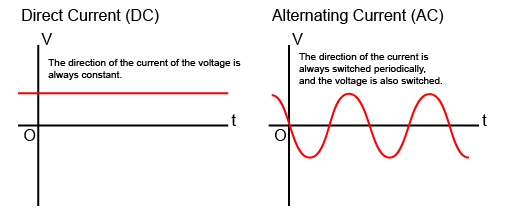There are two types of electricity: direct current and alternating current.
There are two methods of electric current. These are direct current (DC) and alternating current (AC).
Direct current is a method in which electricity always flows in a certain direction, as compared to the flow of a river. It refers to the flow of electricity obtained from batteries, batteries, solar cells, etc.
On the other hand, alternating current (AC) is a method in which the positive and negative sides are constantly switched periodically, and the direction of the flow of electricity changes accordingly. This is the flow of electricity obtained from a generator or outlet. The electricity produced at power plants and sent to homes is also transmitted as alternating current.
The diagram below shows the flow of DC and AC electricity.

In direct current, the voltage is always constant and the electricity flows in a certain direction. In contrast, in alternating current, the voltage periodically changes from positive to negative and from negative to positive, and the direction of the current also periodically changes accordingly.
In direct current, the voltage is always constant and the electricity flows in a certain direction. In contrast, in alternating current, the voltage periodically changes from positive to negative and from negative to positive, and the direction of the current also periodically changes accordingly.
Characteristics of DC power supply
Direct current, in which electricity always flows in a constant direction, has the following merits and demerits.
Advantages
No advance or delay in the circuit
No reactive power is generated
Can store electricity
Disadvantage
Current interruption is difficult
Difficult to convert voltage
Strong electrolytic effect
In alternating current, the direction of the current is constantly changing. Therefore, when a capacitor or inductor is included in the circuit, for example, there is a delay or advance in the current flowing to the load in relation to the voltage behavior.
However, with direct current, the voltage and the direction of the current are always constant, so the behavior of the capacitors and coils is also always constant. Therefore, in DC, there is no advance or delay in the circuit.
In alternating current (AC), the direction of the current is switched, so not all the electricity passes through the load, and some power is generated just traveling back and forth between the load and the power source. This is called reactive power.
In direct current, all electricity passes through the load because the current always flows in a constant direction. This is the image of a scallop being pushed out. Therefore, no reactive power is generated and power can be used efficiently.
Another advantage of direct current is that it can be stored by batteries, batteries, capacitors, etc.














